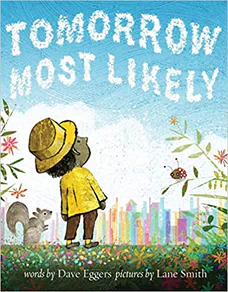Tomorrow Most Likely

Recommended Age Range: Kindergarten through 3rd grade.
Publisher's Summary:
Rather than focusing on going to bed—and what kid wants to think about going to bed?—this book explores all of the dreamy, wonderful, strange things the next day might bring. Whimsical, witty, and hopeful, this revolutionary rewriting of a classic goodnight book from bestselling author Dave Eggers and award-winning illustrator Lane Smith is a bedtime story for tomorrow ever after.

Dr. Annie's Takeaways
Recommended for: For a child who gets stuck in worries about unknowns or unlikely bad outcomes, this book is a fun, silly way to start a conversation about what is “most likely” going to happen tomorrow and how delightful that can be.
Would a child like it? I don’t think this book is necessarily for everyone, but a child who likes books that are a little weird and wacky will enjoy this book. It’s playful and vibrant.
Evidence-Based Practices:
Cognitive Restructuring
Tone: Zany, whimsical
Story Quality: This quirky story is told in (mostly) rhyming verse. It starts out articulating things that will “likely” happen the next day (“Tomorrow most likely there will be a sky. And chances are it will be blue. Tomorrow most likely there will be a squirrel. And chances are his name is Stu”). It goes on to articulate different mundane and fantastical things that might happen tomorrow. A surface read might suggest a random collection of nonsensical events. But a closer read suggests a collection of events reminding children of the magic, pleasure, silliness, mystery, and occasional sadness or challenge that predictably waits for them each new day (e.g., “Tomorrow most likely you’ll smell the good smell of an unknown flower you can’t quite name. Tomorrow most likely you’ll pick up a stone striped like a spiderweb or maybe a brain”). It’s a weird book, but I also loved it.
Illustrations: Complexly textured, colorful illustrations that lend whimsy to the book.
Representation: The main character is a Black boy who lives in a city. Many of the references to events happening “most likely” tomorrow apply to all children, but the illustrations depict scenes of city living (e.g., skyscrapers and streets filled with yellow taxis).
Psychological Practices: This book is a great antidote to anxiety and worry thoughts about tomorrow–it encourages children to think about all of the good things they feel pretty certain will happen tomorrow, and it reminds them that lots of fun and silly things are likely to occur. I’d follow up a reading of this book by prompting a child to think of the pleasurable/fun/interesting/funny things that are likely to happen tomorrow (e.g., “Tomorrow most likely, I’ll eat a big bowl of Frosted Mini Wheats. Tomorrow most likely, I’ll pet Max’s belly and he’ll give me a kiss. Tomorrow most likely, I’ll sit with Amelia at lunch, and we’ll swing at recess”).
Concerns: None.
